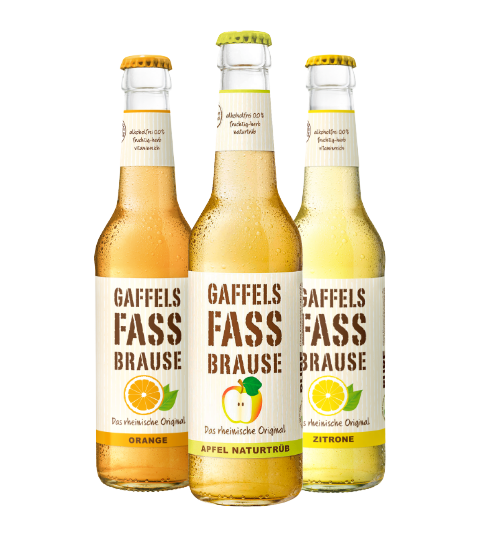
The freshness idea of the Fassbrause
In 2010, the Rhineland original first saw the light of day. Since then, the pure refreshment from Gaffel has become indispensable. Many fans have chosen Fassbrause as their favorite drink. A host of prizes and awards followed, and with Fassbrause Orange and Apfel, two more varieties were added to the lemon.



Refreshingly summer

Refreshment in the city fountain
Fassbrause and brewing art from Cologne
Since we at Gaffel are committed to the traditional art of brewing, we also continue this tradition with our draught beer. This is how the art of brewing becomes the true art of effervescence. We have developed our own, unmistakable recipe for Gaffel’s Fassbrause, giving it its original Rhineland flavor. The flavors lemon and orange are composed of natural flavors, soft brewing water, calcium, magnesium, glucose, folic acid and vitamins B+C. Gaffels Fassbrause Apfel naturtrüb is also enriched with Citra hops.


Gaffels Fassbrause – The Rhenish original
Only Gaffels Fassbrause is the Rhineland original. And for good reason. Because Gaffel founded the segment of modern draft sodas. That’s why we can also call ourselves the original.
Buy and enjoy our Fassbrause
You can buy Gaffels Fassbrause in stores, enjoy it in the Rhineland gastronomy or order it conveniently to your home in our online store.
Discover flavors of our Fassbrause
Nutritional values of Fassbrause
Learn more about the nutritional values and natural ingredients of Gaffels Fassbrause, the Rhineland original. Our Fassbrause is available in lemon, orange and apple flavors.
Dietary fiber
Dietary fibers, which are exclusively of plant origin, are components of food that cannot be broken down or can only be partially broken down by the human digestive system.
Calorific value
The calorific value is the energy released when nutrients are burned in the organism. It indicates how much energy can be obtained from one gram of food when fully utilized.
Calcium
Protein
Like carbohydrates and fat, protein contains the elements carbon, hydrogen, oxygen and nitrogen. These elements combine to form amino acids. They are mainly found in high concentrations as essential protein building blocks (in contrast to meat) in fruits and vegetables. However, proteins are not only energy carriers, but also important building blocks and are also referred to as the basic building blocks of life.
Fats
Fats are energy-rich nutrients that bind and transport fat-soluble vitamins. They are divided into animal and vegetable fats and are composed of glycerol and fatty acids.
Folate
Folic acid, also called vitamin B9 or folate, is a heat- and light-sensitive vitamin from the B-complex. Folic acid is found in small amounts in whole grain products, green leafy vegetables, beet, broccoli, carrots, asparagus, Brussels sprouts, tomatoes, egg yolks and nuts.
Magnesium
Magnesium is an indispensable mineral (alkaline earth metal) for humans and is one of the bulk elements. The human body contains almost 25 g, about 50% of which is stored mainly in the bones. Magnesium shows good effects against stress and in the energy supply.
Sodium
Sodium is an alkali metal that belongs to the bulk elements. Sodium regulates the osmotic pressure outside the cells (extracellular), influences the water balance and the acid-base balance, activates some enzymes as a cofactor, plays a role in transport processes (e.g. in glucose uptake) and, together with potassium, is involved in the transmission of stimuli in the nervous system.
Niacin
Niacin or nicotinic acid belongs to the water-soluble vitamins of the so-called B-complex. It forms an important building block of various coenzymes (NAD, NADP) and is decisively involved in processes of hydrogen transfer in human cells.
Pantothenic acid
Pantothenic acid or vitamin B5 is a water-soluble vitamin from the B-complex and consists of the two components pantoic acid and ß-alanine. Pantothenic acid is necessary for the formation of coenzyme A, which plays an important role in metabolic processes.
Vitamins
Humans are dependent on food rich in vitamins, because their bodies can only produce vitamins themselves in very small quantities. They basically ensure the functioning of the metabolism and mainly have controlling and catalytic properties. They regulate the utilization of carbohydrates, proteins and minerals and help in their breakdown or conversion. Thus, they also serve to generate energy. Vitamins strengthen the immune system and are indispensable in building cells, blood cells, bones and teeth.
Vitamin B6
Vitamin B6 is found in small doses in almost all foods of animal and plant origin. Dairy products, liver, poultry and pork, fish, cabbage, green beans, lentils, lamb’s lettuce, potatoes, whole grains, whole wheat germ, nuts, yeast, avocado, bananas and beer are good sources. Among other things, it is involved in the synthesis of the blood protein hemoglobin and connective tissue, supports the formation of certain neurotransmitters and tissue hormones, such as dopamine, histamine and sterotonin, and promotes the conversion and breakdown of amino acids (proteins), the building blocks of life.
Vitamin C
Vitamin C (collective term: ascorbic acid) belongs to the water-soluble vitamins, is contained in tropical fruits, vegetables, potatoes, among others, and is highly sensitive to the effects of heat, oxygen and light. It performs numerous functions in the body. It is involved in wound healing, the formation of stress hormones (adrenaline and noradrenaline).











